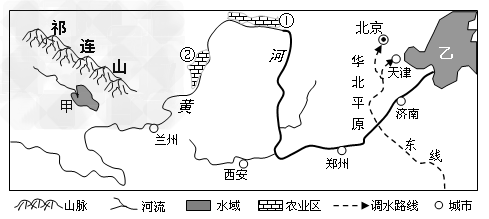问题
综合
读“黄河流域略图”,分析回答问题。

(1)图中祁连山的走向是________,它是第_______级阶梯和第_______级阶梯的分界线。
(2)图中甲地分布有我国最大的湖泊是________;乙是________(海洋)。
(3)图中①和②是我国重要的农业区,它们因得益于黄河水的灌溉而成为“塞上江南”, 其中①是________平原,②是________平原。
(4)为了解决北方缺水问题,我国正在实施的跨流域调水工程是________,该工程的东线(如图所示)主要是满足________、________等城市的用水需求。
(5)图中兰州、西安、郑州、济南等四个城市分布的共同特征是______________。
(6)结合所学知识,简述黄河下游“地上河”的形成原因。
________________________________________________________________________________
答案
(1)西北—东南(或东南—西北);第一级;第二级
(2)青海湖;渤海
(3)河套;宁夏
(4)南水北调;北京;天津
(5)分布在黄河及其支流沿岸(或沿河分布)
(6)黄河进入下游(华北)平原地区,流速减缓,河道变宽,泥沙沉积,河床抬高。
